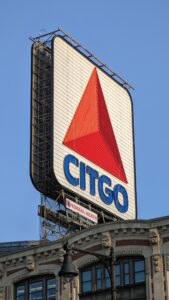By Colin McCandless
Contributing Writer

Photo/Wikimedia Commons
BOSTON – Perhaps no other symbol is more recognizable or beloved by Bostonians than the Citgo sign situated on the roof of the six-story building at 660 Beacon St. in Kenmore Square. The massive sign, made of lights that flash a big red triangle, can be seen on TV during Red Sox games because of its proximity to Fenway Park.
A long history
Although it almost appears to abut the stadium, the hulking structure, measuring 60 feet by 60 feet and attached to a steel truss standing approximately 90 feet tall, is actually located an estimated 1,200 feet from the iconic ballpark’s home plate. It is so popular it has been dubbed the “North Star” of Red Sox nation and nicknamed “See it go,” a reference to home runs swatted over the Green Monster in left field during Red Sox games where it looms as a familiar backdrop. Runners of the Boston Marathon know it well because it serves as a welcoming beacon signaling that they are in the home stretch and the finish line draws near.
Other commercial signs throughout the city have come and gone over the years with little fanfare, but the Citgo sign has endured the elements and attempts at removal.
Despite its association today, the sign didn’t always feature a Citgo logo. In its original iteration, established in 1940, it was emblazoned with a green and white Cities Service logo (the forerunner to Citgo) located on the roof of the oil company’s regional headquarters at the same Beacon Street address. It wasn’t until 1965 following a rebranding that it was converted into the cherished Citgo sign people know today. Arthur King, a native of Pittsfield, Massachusetts, led the design team that created the Citgo sign concept while working with a New York advertising firm called Lippincott & Marguiles. The new sign was constructed that same year over Kenmore Square.
Who turned out the lights?
Bostonians are accustomed to seeing those blinking lights on the Citgo sign, but there was a brief time span when they were shut off, amid the oil crisis of the late seventies and early eighties. The company was asked to turn off the sign beginning on Sept. 4, 1979, at the request of the state energy office as a symbolic gesture of efforts to conserve energy.
Citgo once had plans to remove the sign back in 1982 due to its high maintenance costs, but Bostonians balked at the move and urged that the sign remain and be relit. A group of local residents even petitioned the Boston Landmarks Commission to preserve it as a Boston Landmark. The commission rejected the petition, but their protests were eventually heard as Citgo agreed to keep and maintain the sign for another three years, which flashed once again on Aug. 10, 1983. The joyful occasion marking its return from four years of darkness even involved a relighting ceremony attended by a crowd of enthusiastic supporters. Furthermore, those three years turned into decades as Citgo continued the sign upkeep.
The switch to energy-efficient lighting
While no mortal man can belt a baseball far enough (at least not yet) to hit the Citgo sign, it did sustain fire damage in 2008 that cost $5,000 to repair. It’s also survived hurricanes and other severe weather events. Once comprised of five miles of neon tubing lit by 250 high-voltage transformers, in 2005 the sign underwent renovation to replace the 5,878 glass tubes with LED lights to make it more energy efficient. It entailed the use of 218,000 LED lights to illuminate the sign, resulting in an annual energy savings of over $18,000 for Citgo. The lights went out again briefly in July 2010 when the original LEDs were swapped out for more weather-resistant replacements, but everything was illuminated once again on Sept. 17, fittingly during the seventh inning stretch of a Red Sox game.
More than just a community staple and cultural emblem, the Citgo sign has also earned artistic and aesthetic praise. In 2016, Boston’s NPR affiliate WBUR ranked it number 10 on its list of 50 Best Public Works of Art in Greater Boston. Boston Globe architecture critic Robert Campbell once called it “the crown jewel of the Boston skyline.”
And Bostonians who enjoy the nostalgia of seeing the sign when they visit the ballpark or stroll through this part of the city can rest easy knowing that it’s not going anywhere anytime soon. The Boston Preservation Alliance launched a petition in 2016 seeking landmark status, which it approved two years later. However, the landmark status was vetoed by former Mayor Marty Walsh in 2018 after a 30-year deal was reached among Walsh, real estate firm Related Beal which now owns the building atop which it sits, Boston University, which previously owned the building, and Citgo, to keep the Citgo sign in Kenmore Square.
RELATED CONTENT:
The Channel nightclub was one of Boston’s top live music spots in the ’80s (fiftyplusadvocate.com)
‘Candlepins for Cash’ was a strike for Boston area television viewers (fiftyplusadvocate.com)
Boston’s steaming kettle is 150 years old (fiftyplusadvocate.com)












